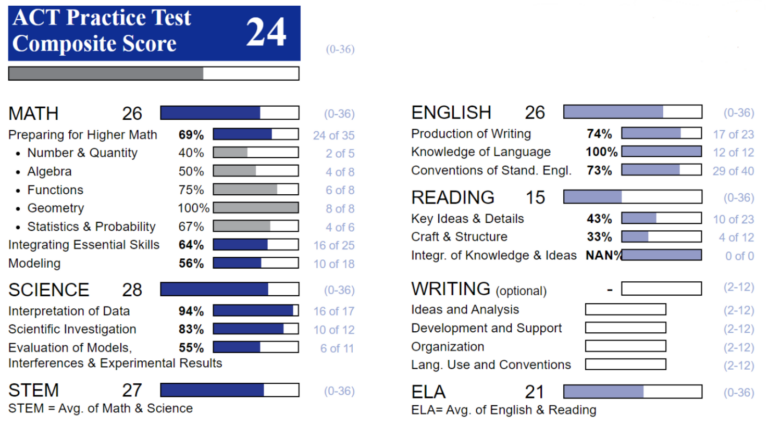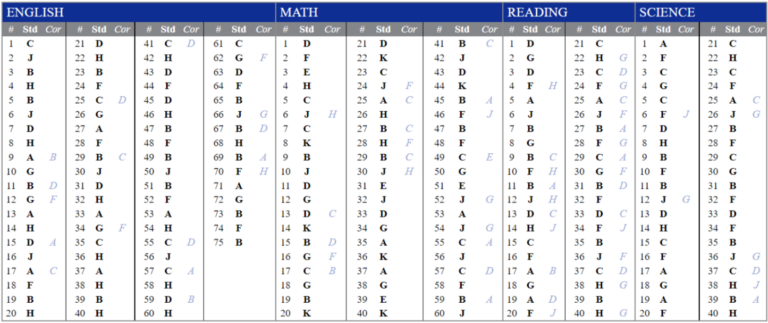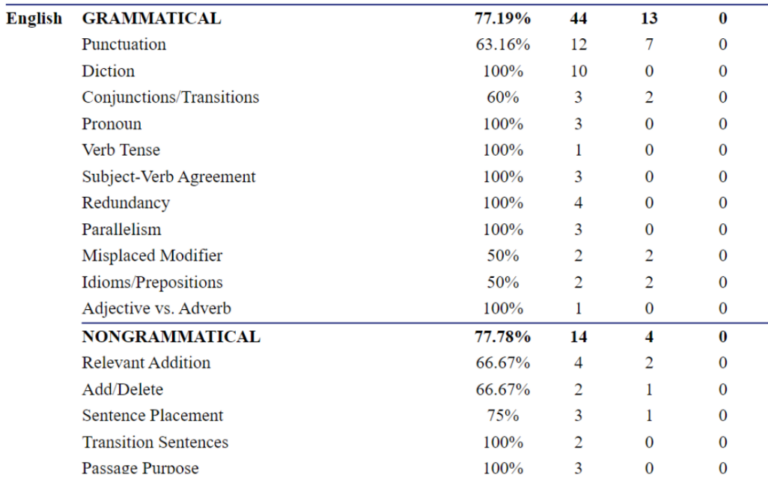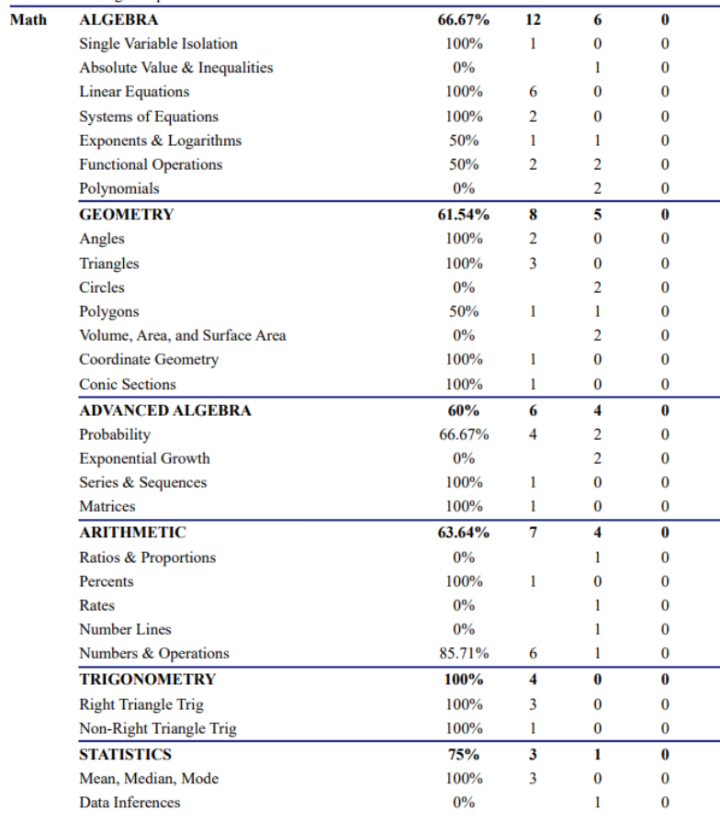If your child is working on test preparation with a Mindfish tutor, they will likely be taking several practice tests through Mindfish. Through your student’s Online Score Tracker log-in, you can see their practice test scores by clicking on the “Scores” tab. Then, you can click on the individual tests to see a detailed score report. Your student’s tutor is practiced at reading these score reports and can provide insights into your student’s performance and progress, but I’d like to provide a comprehensive guide for interpreting these score reports with your student.
In this blog, I will walk through a score report of an actual student of mine, describe how I analyze these reports, and explain the trends that I see in this student’s report.
Reading the Score Report
1. Overall Score
At the top of the score report, as seen in Image 1, you can see your student’s overall score out of 36. This is probably the most familiar part of the score report – you and your student likely have a goal in mind. This is a good number to keep track of, but it doesn’t tell us where to focus our efforts.

Image 1. The total score, section scores, and test scores of a Mindfish practice ACT.
2. Section Scores
Next, also in Image 1, you’ll see the individual section scores (English, Math, Reading, Science) out of 36. These four scores are averaged to get the composite score.
The section scores are based on the test’s score scale, which changes based on the test. This blog post explains how these scores are determined in more detail. And for more information about why different tests have different score scales, check out this blog post.
3. Score History Tracking
Mindfish score reports include a visualization of the student’s score history in each section of the test, as shown in Image 2. Since this was this student’s first practice test, there is only one test listed. Image 3 shows the student’s score history after several practice tests, allowing us to track improvements and struggles in all sections, not just the overall score.

Image 2. Score history section of the test report. This was this student’s first practice test.

Image 3. Score history section of the student’s 3rd practice test report.
4. Question accuracy
The next section of the score report shows us exactly which questions this student missed on the test. This is where we look for issues with strategies like timing. Image 4 shows this student’s question accuracy for their first practice test. The first thing I noticed about this student’s performance is that across all four sections, they tend to miss two or more questions in a row. This tells me that perhaps the student gets nervous when they struggle with one question, and then they aren’t in the best headspace for the next couple of questions.
For math, I see that this student has strong math skills as they were able to answer some of the harder problems at the end of the section, but they may be making simple mistakes at the beginning of the test.
For reading, this student did relatively well on the first reading passage (questions 1-10), but quite poorly on the following passages. The first passage is always fictional, and the other passages are not, so perhaps this student is strong with fiction but not as strong with non-fiction. Alternatively, perhaps this student ran out of time and was rushing on the last few passages.
Science seems to be a strong subject for this student, but they missed a few questions at the end, which may be a sign that they were rushing on the last passage. So, we may need to work on timing for reading and science.

Image 4. Question accuracy from the student’s first score report (score of 24).
5. Test Question Breakdown
This is where we can zero in on topics to work on. We’ll start with the English section.
We can see right away that this student missed a lot of punctuation questions. I would likely review punctuation rules during the first session. I also see that this student missed just a few question types, not one here and there of several types of questions. I would likely urge this student to focus on those topics, especially learning how to identify those question types on the test.

Image 5.
On the math section, I see that this student is strong in trigonometry, but could use some general review in each of the other sections. For example, in the Algebra section, we see that this student should review absolute values, exponents, logarithms, functional operations, and polynomials. This section of the report is very helpful in developing a study plan.

Image 6.
As I mentioned earlier, this student is likely struggling with timing, non-fiction passages, or both. After a discussion with the student, I would likely review some general reading strategies, work on timing a bit, and then revisit reading after another practice test. Since reading is more strategy-based than it is content-based and the student missed so many questions, this portion of the score report isn’t particularly illuminating quite yet.
However, it likely will be helpful after timing and initial strategies get worked out. This section helps us determine whether student is struggling with finding evidence (specific details), inferring from the passage (author intent, inference), using context (main idea, vocab-in-context), or comparing two passages (relationship, specific comparison).

Image 7.
In the science section, I see that the student does well with trend and procedure questions, so we need to focus on strategies for finding data and making connections. Additionally, since the student scored a 28 on science (pretty close to 30), I would want to start focusing on some general science concept review to help out with the Outside Knowledge questions. Since there are only a few outside knowledge questions on the test, they generally aren’t worth the time spent studying until the student is scoring near or over 30 on science.

Image 8.
Next Steps Once You Understand the Report
There are many ways to help your student after reading the score report. Of course, your student’s tutor will use the score report to dictate strategies and concepts to focus on moving forward, but I want to provide some options for how to support your student at home as well.
- Give praise for the successes on the score report.
- Help organize notecards and encourage practice.
- Emphasize the potential shown in the report.
- Help develop a question list for the tutor.
- Ask the tutor how you can support studying at home.




